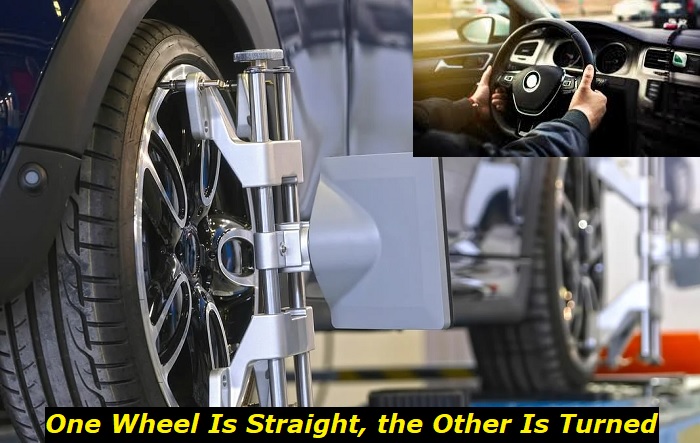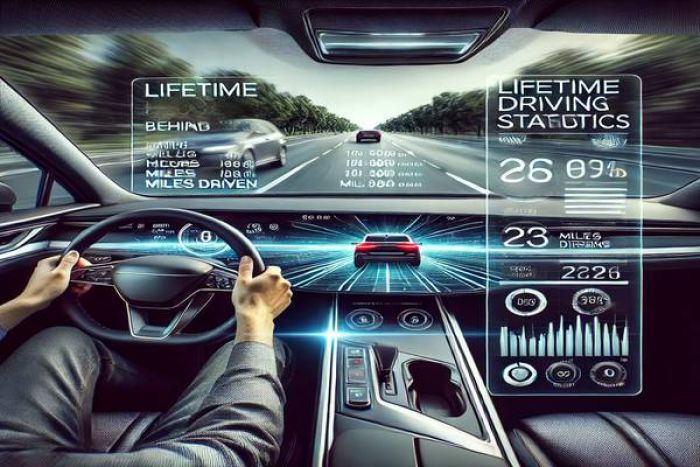One major cause of this issue is a damaged tie rod. The tie rod plays a significant role in ensuring that the wheels respond properly to the movement of the steering. Due to many factors like rough driving and wear, the tie rod could get damaged. This leaves either one or both of the fronts having different angles.
Wheels problems highlights
- Level of importance:medium
- Common reasons:potholes, accidents, lug nut problems
- DIY inspection:possible
- DIY repair:possible
- Average price in shops:$50 - $350
- Average time:0.5 - 3 hours
- If ignored:wobble, wheel falling off, vibration, no drive

What causes one wheel to be straight and the other to turn?
If you notice one of your wheels is straight, and the other is turned, it shows that a part of the wheel or suspension system is damaged. This inconsistency in movements may be due to worn-out parts or rough driving.
Here are some factors that can cause this wheel issue:
1) Damaged tie rod
A major cause of one wheel straight and the other turned is a damaged tie rod. When this part is bent or damaged in any significant way, it could affect the angle of the wheel.
The tie rod plays a vital role in the steering system. It links the steering rack to the steering knuckle. Doing this helps with the proper response of the wheels to steering command and also promotes better handling.
In addition, the tie rod is situated between the front wheel and the steering rack. Its position can easily expose it to serious wear from movement. So, when driving into potholes, you should consider slowing down to reduce the impact on your vehicle. And the end result will be one wheel turning while the other wheel remains in position.
In a worst-case scenario, a broken tie rod will cause the affected wheel to break free from the steering assembly. This means the tire will not respond to steering commands. The resulting loss of control can cause accidents.
2) Worn-out ball joint
Another cause is a failed ball joint. Once this part is worn out or fails, the suspension is affected, which will also lead to structural issues with the affected wheel.
The ball joint provides a link between the steering knuckle and the control. This link allows for pivoting movement and better handling.
Once the connection is damaged, the affected tire will tilt out of position, making the wheel appear as though one tire is turned and the other is straight. Again, if you suspect this to be the case, stop driving your vehicle, as it may lose control.
3) Damaged suspension control arm
A damaged suspension control arm may also cause the wheel of your car to tilt. This component, when bad, will cause one of the wheels to become misaligned while causing the vehicle to pull to one side when driving.
The suspension system also known as the control arm connects the chassis and the suspension hub, which is responsible for carrying the wheel.
Having a damaged suspension control arm will mainly affect the steering structure of your car. For instance, if the control arm is bent or broken, the joint may begin to slowly loosen or disconnect.
Consequently, the wheels will not have a proper angle. As such, each wheel will move in a different direction to the other. You may notice the affected wheel becomes less responsive to steering commands.
4) Damaged struts
A weak or worn-out damaged strut will no longer be able to carry the weight of the vehicle. When this happens, the suspension and alignment of the wheel are generally affected.
The strut is a part of the suspension system jointly used in conventional suspension systems. When damaged, it affects the condition of the steering, brake, suspension, and wheel structure. Since this part plays a structural role in the wheel, damaged suspension can affect the position of the tire. If the problem is not checked fast, the wheel's angle may change over time. This will be obvious when you compare both front wheels.
Furthermore, a misaligned front wheel or, in extreme cases, a completely disconnected wheel may be the result of a driver's carelessness. To be on the safe side, avoid driving if you notice that one of the wheels of your vehicle is turned and the other straight. It is imperative that you get the problem fixed immediately.
How To Fix a One Wheel Is Straight, Other Is Turned
The first thing you need to do when faced with an issue like this is to carry out a proper diagnosis. Most of the time, this problem arises after an accident or when the vehicle is driven fast into a pothole.
To diagnose what the cause could be, you need to physically examine all potential parts that could cause the issue. This would include examining major parts of the suspension, steering, and wheel system.
Below are ways to fix when one wheel is straight and the other is turned.
1) Check and fix the damaged tie rod
A bad tie rod may appear through different symptoms. They include vibration in the steering wheels, a clunking sound when turning, the front end being out of alignment, and more. Nevertheless, the presence of some of these symptoms may not necessarily mean you have a damaged tie rod.
To be completely sure, a physical inspection is needed.
First, lift the front side of the vehicle and place your two hands on the tires at the 3 and 9 positions. Shake both tires to know if it is firm while checking for noises. If the wheel is not held in place properly, then the tie rod may be bad.
If you are not satisfied with that inspection, you can take out the tires and inspect the tie rod. Check the inner and outer parts for leaks or significant damages like bends and broken connections. If found, go ahead and have the tie rod replaced immediately.
2) Check and replace the ball joint
A damaged ball joint comes with obvious symptoms like clunky or squeaky noise, shaky steering, and a car drifting to one side when driving. However, you should check the part just to be sure it is responsible for the issue with the wheel.
Lift the vehicle and find the ball joint, which is at the end of the control arm. Once you are able to find the part, inspect it for cracks or disconnection.
If the damage is found at the lower ball joint, then that can be replaced; however, if it is the upper ball joint, you may have to replace the whole control arm.
3) Check and replace the strut
When the strut is bad, you will notice some signs like bouncy rides, swaying vehicles, uneven tire wear, and more. There is a simple way to test this part: try using your body weight to bounce the body of the vehicle from the side of the affected wheel. If there is a lot of movement, then the components are most likely damaged.
However, physically inspecting the struts is the best way to check and diagnose the strut.
A strut includes the dampener and the spring assembly, which is considered one unit. Lift the vehicle and inspect the part; if it is covered with fluid and not completely dry, then it is most likely damaged. You will need to have the part replaced.
4) Check and replace the control arm
A bad control arm has signs like popping noise, unstable steering, and uneven tire wear. To check for a damage control arm, jack the vehicle up and place your hands on the affected tire in the 9 and 3 position. Shake and observe for clunking sounds or wiggling wheel.
Remove the wheel and check the lower and upper control arms. You can give it a shake; if it is not firm and still makes that clunking sound, you need to have it replaced.
Final Thoughts!
When faced with one wheel straight and the other is turned, people tend to mistake it for an alignment issue. They, therefore, take their vehicle for alignment just to have the issue creep up again. The problem is caused by damaged components of the wheel and suspension that need to be repaired or replaced. If they are completely ignored, you may end up with a more serious problem.
For a better diagnosis and fix, we advise that you take the vehicle to a professional. This will ensure that the issue is properly tackled and further damages are totally avoided.
If you have any questions, ask in the comments below.
About the authors
The CarAraC research team is composed of seasoned auto mechanics and automotive industry professionals, including individuals with advanced degrees and certifications in their field. Our team members boast prestigious credentials, reflecting their extensive knowledge and skills. These qualifications include: IMI: Institute of the Motor Industry, ASE-Certified Master Automobile Technicians; Coventry University, Graduate of MA in Automotive Journalism; Politecnico di Torino, Italy, MS Automotive Engineering; Ss. Cyril and Methodius University in Skopje, Mechanical University in Skopje; TOC Automotive College; DHA Suffa University, Department of Mechanical Engineering






Add comment